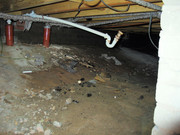Here's the issue, new washing machine installed. Has the potential to go up to 1600 spin however I'm limited to 600 spin otherwise floor vibration excessive. No transit bolts have been left in and all feet are on the ground and machine appears level. Although my previous machine didn't vibrate the floor much if at all, this new machine is.
I suspect the issue is the wooden floor. I don't want to muck about with vibration pads under the machine, if nothing else space is very limited. I can get under the house. If I was to consider throwing down a few slabs on the ground under the machine area (in line with nearest joists) and shore up with some 4x4 jammed in and appropriately secured, do you reckon this will alleviate the issue and enabling me to open that baby up spin wise?
Or, in doing this, could I be causing potential structural damage to my property i.e. displacing the stresses when the machine is spinning? I'm in a timber kit house if of relevance.
I suspect the issue is the wooden floor. I don't want to muck about with vibration pads under the machine, if nothing else space is very limited. I can get under the house. If I was to consider throwing down a few slabs on the ground under the machine area (in line with nearest joists) and shore up with some 4x4 jammed in and appropriately secured, do you reckon this will alleviate the issue and enabling me to open that baby up spin wise?
Or, in doing this, could I be causing potential structural damage to my property i.e. displacing the stresses when the machine is spinning? I'm in a timber kit house if of relevance.


